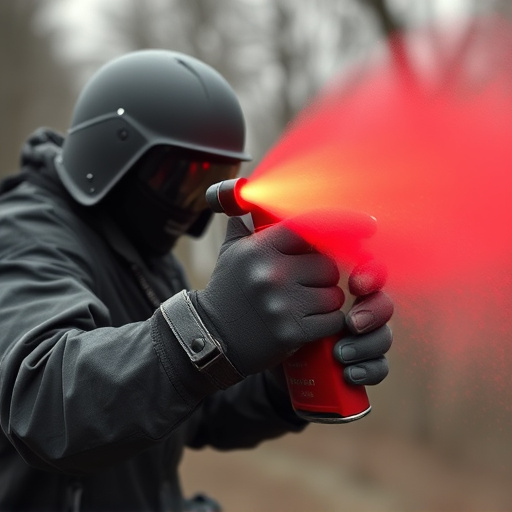Non-lethal deterrent devices like pepper spray offer a safe alternative to lethal force, temporarily incapacitating assailants without permanent harm. While effective, removing pepper spray from clothing is difficult. Proper decontamination procedures, including quick removal of outerwear and handwashing, are crucial for user and bystander safety. Understanding legal considerations and learning proper handling, deployment techniques, and decontaminating methods like effectively removing pepper spray from clothing maximize these tools' effectiveness in diverse scenarios. Regular training ensures confident and effective use during stressful situations.
“Personal security is a growing concern in today’s world, prompting individuals to seek effective non-lethal deterrent devices. This comprehensive guide explores one such tool: pepper spray. We’ll dissect its mechanics, benefits, and drawbacks, focusing on a crucial aspect—how to properly remove pepper spray from clothing after use.
Additionally, we’ll navigate legal considerations and safety precautions, offering insights into responsible self-defense practices, especially when it comes to understanding the nuances of removing pepper spray from fabrics.”
- Understanding Non-Lethal Deterrent Devices: A Comprehensive Overview
- The Role of Pepper Spray in Personal Security: Pros and Cons
- Strategies for Effective Deployment: Remove Pepper Spray from Clothing
- Legal Considerations and Safety Precautions for Non-Lethal Self-Defense
Understanding Non-Lethal Deterrent Devices: A Comprehensive Overview
Non-lethal deterrent devices, also known as less-lethal weapons or alternative force options, are designed to incapacitate or deter individuals without causing permanent physical harm. These tools have gained significant attention in law enforcement and personal security circles as a more responsible approach to force application. One of the most common types is pepper spray, which has been a staple for self-defence for decades.
While pepper spray is effective in disrupting an assailant’s vision and respiratory system, it doesn’t leave permanent injuries. However, removing pepper spray from clothing after use can be challenging. It’s crucial to understand that proper decontamination procedures are essential to ensure the safety of users and bystanders alike. Effective non-lethal deterrent devices not only protect individuals but also minimize potential damage, making them valuable tools for personal security in various scenarios.
The Role of Pepper Spray in Personal Security: Pros and Cons
Pepper spray, a non-lethal deterrent, has long been a staple in personal security devices. Its primary role is to incapacitate an assailant by causing temporary blindness and respiratory distress, allowing the user to escape or seek help. One of its significant advantages is its relative simplicity; it’s easy to use and requires minimal training, making it accessible to a wide range of individuals seeking self-defense options. Moreover, pepper spray can be carried discreetly, providing peace of mind in potentially dangerous situations.
However, there are drawbacks to consider. Remove Pepper Spray From Clothing can be challenging, as stains and odors can persist, causing discomfort and potential health issues if not properly handled. Additionally, its effectiveness is situational; wind or the assailant’s protective gear could reduce its impact. Despite these cons, pepper spray remains a popular choice for personal security due to its quick response time and non-fatal nature, offering users a crucial window of opportunity in potentially life-threatening scenarios.
Strategies for Effective Deployment: Remove Pepper Spray from Clothing
When considering a non-lethal deterrent like pepper spray for personal security, one crucial strategy is to understand how and when to deploy it effectively. A common mistake is carrying the spray while wearing clothing that can trap the irritant, negating its impact. Removing pepper spray from your clothing is essential before use. This includes taking off jackets, sweaters, or any outerwear that could retain the spray, ensuring it reaches the target area directly.
Additionally, wash your hands thoroughly after deployment to prevent accidental transfer of the spray to sensitive areas like eyes or mucous membranes. Proper deployment techniques and being aware of how to maximize the effect of non-lethal deterrents are key to ensuring their reliability in dangerous situations.
Legal Considerations and Safety Precautions for Non-Lethal Self-Defense
When carrying a non-lethal deterrent, such as pepper spray, understanding legal considerations and safety precautions is paramount. Each jurisdiction has specific laws regarding self-defense and the use of force, including non-lethal options like pepper spray. It’s crucial to familiarize yourself with these laws to ensure compliance and protect your rights. For instance, some areas have restrictions on the type and quantity of pepper spray allowed, as well as permissible uses.
Safety precautions extend beyond legal boundaries. Users must learn how to properly handle and deploy their device to minimize risks. This includes understanding the range and effectiveness of the spray, ensuring it’s easily accessible during an emergency, and knowing how to remove pepper spray from clothing or skin without causing additional harm or discomfort. Regular training and practice are essential to build confidence and ensure effective deployment in high-stress situations.
In conclusion, non-lethal deterrent devices like pepper spray offer a valuable tool for personal security. However, effective deployment strategies, such as promptly removing pepper spray from clothing after use, are crucial to ensure safety and minimize legal repercussions. Remember that understanding the pros and cons, including the specific challenges of removing pepper spray from fabrics, is essential for responsible self-defense. Always follow safety precautions and be aware of local laws to make informed decisions in potentially dangerous situations.
